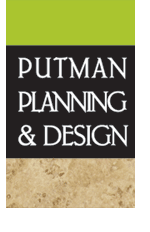
Marc Putman, principal of Putman Planning & Design, Inc. and Registered Landscape Architect has confirmed his long commitment to sustainability by achieving the significant, added professional credential; "LEED AP".
LEED stands for "Leadership in Energy and Environmental Design. AP stands for "Accredited Professional". The title conveys evidence of "Green" professional capabilities in building design, urban & site planning, and building technologies. For municipalities and private clients, the LEED AP can help achieve improved sustainability, significant energy savings and green building qualities.
The LEED AP examination is 2 hours long and covers 420 pages of sustainability & green criteria and procedures. Marc's over three decades of experience in real estate, building and development was invaluable for the long study and the exam, itself.
The Hudson-based Landscape Architect notes that; "Government leaders & staffs, business & home owners now must grapple with impacts of the changed environmental and economic climate. Becoming more "Sustainable" and "Green" are becoming commonly stated goals, these days. But, there is confusion over what that means, and what actions to take. The experienced landscape architect with the added LEED Accredited Professional knowledge brings specific know-how and action steps to these challenges."
Further, Putman observes that the title "LEED AP" provides recognition and verification of Putman Planning and Design's long history of seeking more efficient a0nd attractive design solutions for homes, townhomes, neighborhoods, and cities.
"For over 3 decades, our work has focused on more sustainable design, in all its aspects: efficient land plans, reduced fuel use, lower purchase prices, controlling building energy consumption, elevated affordable, attractive densities, ability to age-in-place ... integral with beautiful and safer streets; distinctive homes, linked to attractive shopping areas, schools & parks."
"Sustainability" is at last becoming seen as a sound basis for neighborhood densities. This is because they can allow more affordable prices, but with better amenity. Mixtures of uses, traffic calming streetscapes, clustered homes and linked openspaces are becoming recognized as a better marriage of housing needs with environmental quality. Residents, families and neighbor groups are coming to see that a neighborhood is not economically or aesthetically "Sustainable", if the sale prices are driven too high by land use regulations, exactions and outdated market conventions."
"Seemingly narrow, project-specific issues have much wider impacts. From a sustainable municipal governance standpoint, the civic fabric of a community is made weaker by failed businesses and residential properties that stand empty, or sell slowly, at distressed prices. The more Sustainable municipalities structure their laws, rules and incentives to create a firm marriage of economic prosperity with more than mere basic function. Integrated function with beauty engenders higher property values and loyalty. The truest test of the "sustainability" of a "Place", after all, is whether the residents, owners, managers and customers will provide support over a long span of time, with their attention, energies and money."
"We have each witnessed this contrast ourselves. Unattractive buildings and blocks gradually fall into cheap and tasteless refurbishments, disrepair, and eventually are torn down. In contrast, prized buildings and spaces of quality in design and materials are well kept, defended against decay and destruction. Ultimately, We The People vote with our private and government energies & dollars to literally 'Sustain' these prized "Places". The challenge is, of course, to know what creates Places of enduring value.
Putman explains that the U.S. Green Building Council established the LEED AP program to establish a points system so that projects could gain a rating & recognition for the level of sustainability and green renovation, building or development they achieve. The reviews and scoring are very specific, detailed and comprehensive. Points are totaled from each of 6 categories:
- Sustainable Sites,
- Water Efficiency,
- Energy & Atmosphere,
- Materials & Resources,
- Interior Environmental Quality,
- Innovation & Design Process
Achieving 26 points gains a "Certified" LEED rating, followed by "Silver" and "Gold." 69 points wins a "Platinum rating.
He observes that; "many will choose not to seek a LEED rating, but rather, will still benefit from incorporating many of the cost-effective aspects of LEED's energy and environmental recommendations.
For assistance in your next project, contact Marc Putman at 715.381.8291, or email Marc@putmanplanninganddesign.com.
| Our View on Sustainability |
|
Urban Infill
|
|
|
|
Cluster Conservation Development
|
|
|
|
Commercial Sustainability
|
|
|
|
Transit Oriented Development (T.O.D)
|
|
|
| back to PORTFOLIO BY SERVICE |